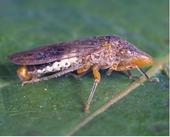- Author: National Pesticide Information Center (NPIC)

Acetic acid, also known as vinegar, is used in products for weed control. Many people choose it because it is natural. However, acetic acid can damage skin and eyes, especially at concentrations commonly found in weed killers.
What is the difference between acetic acid, vinegar, and horticultural vinegar?
You may know acetic acid best as vinegar. Vinegar is a solution of acetic acid in water. Acetic acid is a naturally occurring substance that is found in all living things. It is formed during fermentation. Acetic acid can also be made industrially. It is used in many industrial processes, including the manufacture of dyes, plastics, some drugs, and other industrial chemicals. It is also used in textile...
- Author: Belinda Messenger-Sikes

Exotic and invasive pests threaten California's natural environments, agricultural production, structures, landscapes and gardens. Exotic pests are organisms introduced into an area beyond their natural range and become pests in the new environment. Most introductions have been unintentional and accidental, but some invasive plant problems began as ornamental plants for sale.
Invasive species prevention is the most economical and desirable approach to invasive species management. However, when prevention isn't successful, pesticides may be needed to eradicate or control invasive species.
What are some problematic invasive species?
Aedes mosquitoes can transmit...
- Author: Belinda Messenger-Sikes

Pesticides and fertilizers applied around homes, residential or commercial landscapes, school sites, and other areas can enter our creeks, rivers, and oceans, degrading water quality. While pesticides and fertilizers can be useful in controlling pests and helping plants grow, their overuse and misuse can harm the environment and human health.
To find out more, see our updated pages on urban pesticides, fertilizers, and water quality. These pages feature plain language definitions of toxicity and water quality and explanations of how pesticides and fertilizers get into our waterways. There's also information about how you can protect our creeks, rivers, and oceans when managing your home and landscape.
Learn about urban...
- Author: Lauren Fordyce
- Author: Belinda Messenger-Sikes
- Author: Karey Windbiel-Rojas

You've heard of terms such as green, organic, natural, ecofriendly, and less toxic to describe pest control products and services. But what do these terms really mean? To different people, they can mean different things, creating obvious confusion. But some of these terms have specific meanings, regulations, and rules when referring to pesticides and pest control. This article aims to clarify the differences.
What is organic?
Some people think organic means no pesticides, but that is incorrect. The term organic (in the context of food production and pest control) can mean no pesticides were used, but it can also mean that only organically acceptable pesticides and fertilizers were...

Follow these tips for the month of July to prevent pests in the garden and landscape. To see more tips specific to your region, visit the Seasonal Landscape IPM Checklist on the UC IPM website.
- Clean up fallen fruit or nuts to avoid attracting or harboring pests.
- Deter borers by deep watering trees that are adapted to summer rainfall. Avoid pruning or creating open wounds that can also attract borers.
- Cover fruit trees with netting to exclude birds and other


